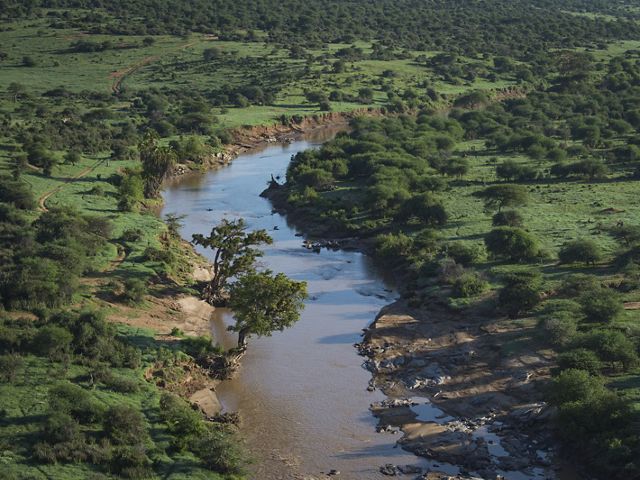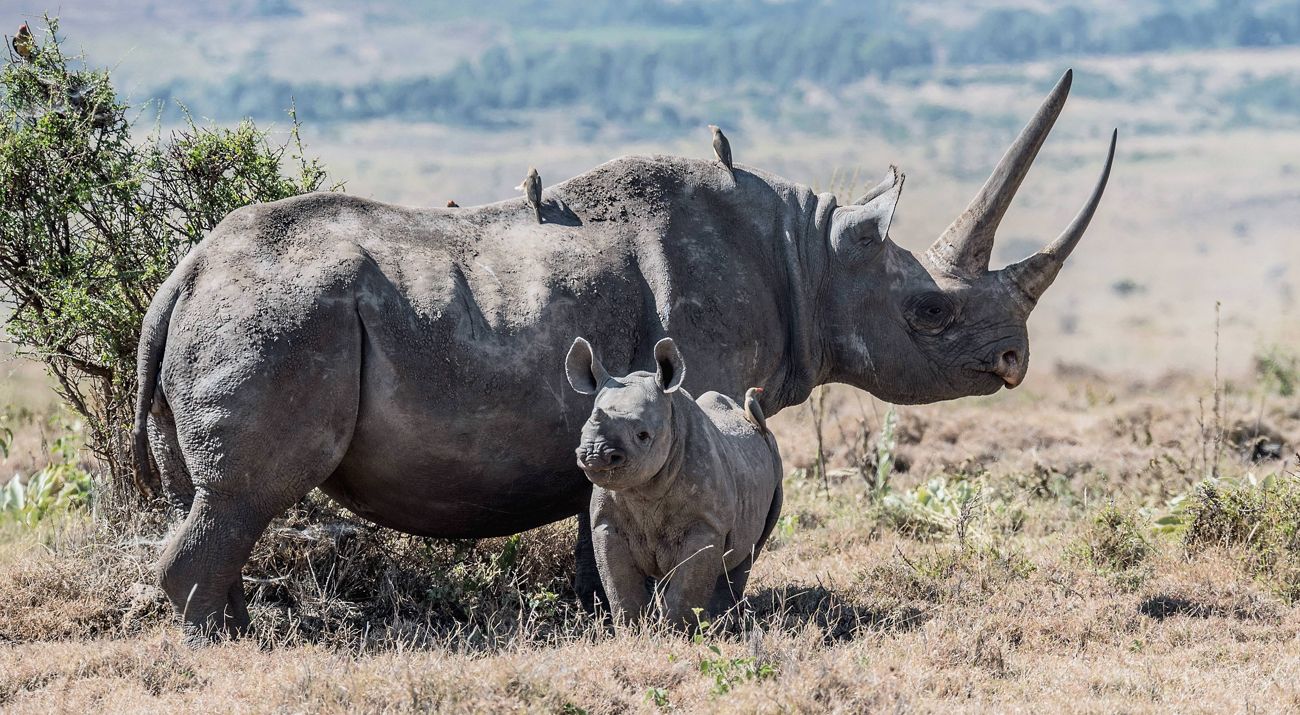Support the Rhino Sanctuary
Donate Now"The Big Five": elephants, African buffalo, lion, leopard, and rhino. These animals fuel dreams of traveling to East Africa for people all over the world.
Sadly, these animals aren’t as easy to see as they used to be—especially the rhino. Although the eastern black rhino’s range used to include South Sudan, Uganda, and Ethiopia, they are now found mainly in Kenya and parts of Tanzania and Rwanda.
In fact, the vast majority of Kenya’s remaining rhinos live in protected sanctuaries. This is because Kenya’s black rhino population dropped from more than 20,000 in the 1970s to a low of fewer than 400 animals in 1987. That’s a decline of 98 percent in less than 20 years due to rampant poaching for their horns and degradation of critical habitat.
TNC Africa Director Matt Brown and TNC Kenya Program Director Munira Bashir answer questions about the status of rhinos and Kenya and a bold plan to help save them.

Q: How are rhinos doing in Kenya?
Munira: Black rhino populations in Kenya have almost doubled from their low point in the late 1980s to just over 850 animals, which is great. But there is still a long way to go from the Kenyan government’s goal of 2,000 individuals, the minimum number necessary to ensure the long-term survival of the species.
Matt: The limiting factor now is space. The majority of rhinos remaining in Kenya are in sanctuaries, which is important since poaching is still a very real threat and any rhino lost now is a big step in the wrong direction.
But these sanctuaries are now overcrowded. At a certain ecological carrying capacity, rhino reproduction rates begin to decline, which stalls the population growth.
Q: So what is the solution?
Matt: We need to find more appropriate habitat for rhinos so that we can spread them out. They need a place with the right vegetation, the right security in place, and the right overall suitability for the animals to thrive. That place is Loisaba Conservancy.
Munira: According to feasibility assessments carried out by the Kenya Wildlife Service (KWS), Loisaba Conservancy in Laikipia is historically an ideal spot for a rhino sanctuary. The Kenyan government has given conditional approval to relocate rhinos to Loisaba. Our next step is to raise the funds that will enable us to fulfill those conditions. We are looking forward to working with KWS to help them reach their ambitious goal and ensure the survival of this amazing species.

Q: What makes Loisaba the perfect place?
Matt: Fifty years ago, rhino were abundant on the land that is now Loisaba Conservancy, so we know it’s great from an ecological perspective. Black rhinos are browsers, and the shrubs and bushes at Loisaba will provide the nutrition they need, along with the cover and protection these solitary animals crave.
But also importantly, thanks to TNC supporters who helped transition Loisaba from a private ranch to a wildlife conservancy, it already has much of the basic infrastructure in place, including trained security teams and good roads. It also serves as a conservation and research hub for other key species, including reticulated giraffes and leopards, and it has a strong collaboration with the local communities.
Q: What’s involved in relocating rhinos?
Munira: A lot of work is required before the translocation of rhinos can be done. Many assessments must be conducted to ensure that the location is suitable to support rhinos, including an ecological assessment, a disease risk assessment, a security assessment, an operations audit, and a fence survey with accompanying environmental impact assessment.
Then, there is the need to prepare the location with specialized infrastructure, including constructing a rhino-proof fence around 24,000 acres within the conservancy. We'll build out the security team with rhino rangers, new vehicles, and state-of-the-art monitoring equipment. And we'll prepare for five years of operations costs, including ongoing veterinary care, habitat management, and community awareness.
Then we will work closely with KWS to determine where the rhinos will come from. Ideally the rhinos would come from several different locations to diversify the gene pool. Of course, that also makes the logistics of transport a little more difficult.
Matt: Moving a one-ton animal is no easy feat! The main goal is to keep each rhino as comfortable as possible on their journey from one location to another. This all requires a lot of coordination with skilled professionals, including KWS veterinarians, drivers, security, and support staff.

Q: Tell me more about the new fence. Would that be detrimental to the other wildlife at Loisaba?
Matt: No conservationist loves the idea of fencing. But we will install special fences that can keep rhinos in but allow other animals to move freely.
A typical fence with a few wires allows most animals – such as antelopes, lions, or wild dogs — to go over, under, or through it. For larger mammals, such as elephants and giraffes, we will create large fence-gaps that consist of a sloping, loose rock wall. Because of a rhino’s short, stubby legs, they are unable to scale these rock piles, although they present no problems for the other large mammals.
It’s an important solution because these rhinos will need our protection. Rhino poaching is still a very real threat: nearly 400 rhinos were lost in South Africa last year and 2020 was actually the first year in 21 years that not a single rhino was poached in Kenya.
Q: What would rhinos on Loisaba mean for this landscape?
Munira: From an ecological restoration perspective, securing this habitat and bringing rhinos back to this landscape would be an incredible conservation success story. Rhinos are a keystone species that are especially important to an ecosystem, including spreading nutrients for a complex food chain.
And we believe that having the “Big Five” at Loisaba will bring additional tourists. Increased tourism means more jobs for the local community and more community development projects.
Q: So what’s next?
Matt: This is a big, bold idea. But so are our supporters. In 2015, we came together to save Loisaba Conservancy from development and, because of that ambition, we now have the chance to help increase eastern black rhino populations in Kenya.
Loisaba has passed all the preliminary water, vegetation, security and habitat assessments—what’s missing is the funding! Will you help us reach our goal of $5.1M by the end of 2021 in order to bring black rhinos home to Loisaba?
You can donate online here or, for more information, please contact Nancy Light at nlight@tnc.org.
